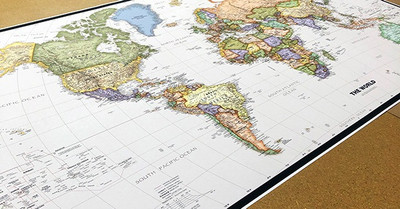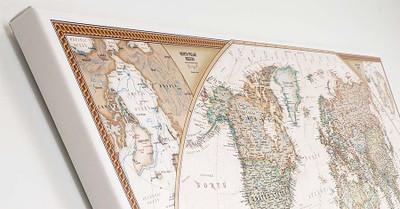
Historic Railroad Map of Ohio - 1882
Description
Cleveland was founded in the late 1700's along the shores of Lake Erie, near the mouth of the Cuyahoga River. As several canals and effective railroad lines were added, Cleveland quickly became an important manufacturing town. The city was incorporated in 1836.
Cleveland was conveniently connected with the Atlantic Ocean, by way of the Erie Canal and the St. Lawrence Seaway, and the Gulf of Mexico, via the Mississippi River. By the late 1800's Cleveland was an major transportation center for iron ore and other raw materials being moved across the Great Lakes.
A rail disaster of epic proportion occurred in the winter of 1876 near the bustling ore and coal port town of Ashtabula. The railway bridge over the Ashtabula River collapsed casting train number 5, The Pacific Express with 159 people on board 150 feet below into the frozen river waters. In all 92 people were killed and 64 injured.
Toledo was founded along the west bank of the Maumee River in 1833. With the addition of canals, and later with its position along the railway between New York and Chicago, Toledo grew fast. Toledo was a major glassmaking town, producing windows, bottles and glass art, and boasting furniture manufacturers, carriage makers and breweries. When the railroads began to replace the canals as the preferred mode of transportation, Toledo became a prominent center for several railroad companies.
This map was published in 1882 by H. Sabine. It shows cities, towns, counties, waterways, and clearly labeled railroads with mileage noted between stations.
Included is a list of Ohio counties and townships.
Materials
Archival Paper

Premium fine art paper that provides accurate color reproduction with high-contrast, high-resolution print output and maximum image permanence. A high-quality print ready for framing.
More
- Museum quality paper for high-quality fine art.
- Ultra smooth, neutral white matte finish.
- Heavy-weight 230 gsm, 9.5 mil thickness.
- Printed with pigment inks for longer print life and enhanced fade resistance.
- Pigment based Canon LUCIA inks provide smooth tones and rich colors in fine, precise detail.
Luster Photo Paper

A premium semi-gloss photo paper with a subtle texture that produces a vivid, richly detailed print. This material results in an exquisitely detailed giclee print of substantially higher quality than a standard poster.
More
- Printed on 10 mil premium luster photo paper resulting in a brilliant, colorful image with a vivid life-like quality.
- Pigment based Canon LUCIA inks provide smooth tones and rich colors in fine, precise detail.
- Inks have a lightfastness rating of over 100 years, guaranteeing minimal noticeable fading over a very long period of time.
- Printed using very high resolution source files.
- Giclee printing is superior to traditional lithography in a number of ways: colors are brighter, lasts longer, and is a higher resolution.
Canvas on Wood Rails

A canvas giclee print is mounted to wooden hanging rails placed along the top and bottom of the map. Ready to hang on the wall using the attached hanging cord. Wood rails feature a natural finish.
More
- Premium 19 mil canvas material.
- Wood rails are 1 1/8" wide, round front.
- USA sourced solid maple wood.
- High quality giclee fine art print with a lightfastness rating of over 100 years.
- Pigment based Canon LUCIA inks provide smooth tones and rich colors in fine, precise detail.
Canvas Gallery Wrap

A high quality canvas giclee print is hand stretched over a sturdy wood frame. Printed on demand and handcrafted in Seattle, WA. The canvas gallery wrap serves as a stunning piece of art ready to hang on your wall.
More
- Premium 19 mil canvas material.
- Pigment based Canon LUCIA inks provide smooth tones and rich colors in fine, precise detail.
- High quality giclee fine art print with a lightfastness rating of over 100 years.
- Durable canvas mounted to a 1" deep wood frame.
- Ready to hang with included easy-to-use hanging kit.
Framed Map Print - Black Finish

Our gallery quality frames are made of solid wood and feature optical-grade acrylic. Each framed map is printed on premium archival matte fine art paper.
More
- Printed on thick, luxurious acid-free fine art paper & dry-mounted to foam board.
- Pigment inks ensure a vivid print with amazing colors and excellent fade resistance.
- Solid wood frame with a black finish has a 1.25" face & 7/8" depth.
- Kraft paper protective backing & hanging wire installed.
Framed Map Print - Natural Oak Finish

Our gallery quality frames are made of solid wood and feature optical-grade acrylic. Each framed map is printed on premium archival matte fine art paper.
More
- Printed on thick, luxurious acid-free fine art paper & dry-mounted to foam board.
- Pigment inks ensure a vivid print with amazing colors and excellent fade resistance.
- Solid wood frame with a natural oak finish has a 1.25" face & 7/8" depth.
- Kraft paper protective backing & hanging wire installed.

Made In The USA

School Purchase Orders









